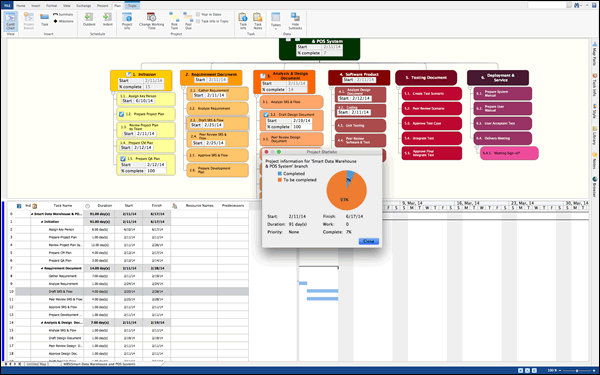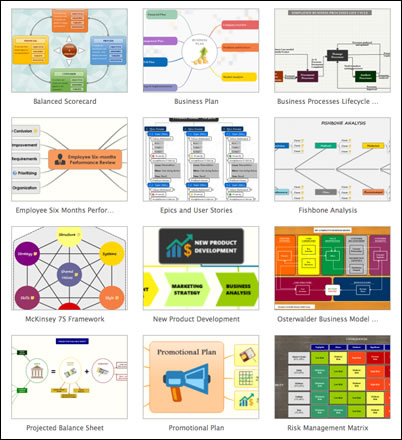
The new iMindQ 6 from Seavus features a well-designed new presentation mode, enhanced project management tools and other improvements clearly aimed at the needs of busy business people.
When iMindQ was launched only three months ago it was an impressive mind mapping program, worthy of your attention. But its developer hasn’t rested on its laurels. It continues to add new functionality to this well-designed visual mapping tool, while also maintaining its ease of use. The latest release of iMindQ, version 6, was launched in mid-October.
Here’s what’s new and notable in this new release:
Rich presentation mode
This new version of iMindQ offers a rich presentation mode that enables you to present your ideas with style. Best of all, Seavus hasn’t followed the lead of many mind mapping programs in moving to a slide-based presentation view, which displays topics in isolation and makes it hard for audiences to follow where you are within the structure of your mind map. Rather, it uses the superior model of “flying” around it, which helps the audience better follow your flow of ideas and information.
To access the presentation mode, simply click on the “from beginning” button in the “present” tab of the program’s ribbon toolbar, and iMindQ 6 immediately launches a full-screen view of your mind map. You can advance to the next topic using either your mouse or the space key. As you progress through the child topics of your map, they are highlighted in a different color, making it easy for the audience to follow along. Child topics “pop” open with a pleasing animation.
In addition to an automatic mode for generating presentations, iMindQ 6 enables you to manually “roll your own” using what the developer calls “Smart Presentation Mode.” You can use iMindQ’s default settings to generate “scenes” (the equivalent of slides in PowerPoint) and then tweak them to suit. You can also manually create new scenes by dragging and dropping one or more map topics onto a blank scene.
The animations panel to the right of the program’s work area displays each step in the selected scene’s animation at the top of this panel; controls to adjust the animation type, effects and timing are located at the bottom. Once you’ve adjusted the scene’s properties, you can preview it in the presentation view of your mind map in the middle of the screen – it’s nice to be able to do this without having to play your presentation. A “show panels” button can be used to display them so you can tweak your presentation, or they can be toggled closed to give the screen a cleaner appearance, ideal for thinking about how you want to present your ideas.
Whether you’re working with a mind map, flow chart, concept map or GANTT chart, the process works exactly the same. You can let the program create a set of scenes for you and then tweak them to meet your needs, or you can add your own using the process I just described for mind maps.
I played around with the default mind map that opens automatically in iMindQ 6 and found the presentation view and controls to be very easy and intuitive to use. It’s nice to see a mind mapping program that gives you this much control over presentation settings and which uses the “fly around” presentation mode I mentioned at the beginning of this review.
New project planning options

In iMindQ 6 you can now manage and set working hours according to your project’s needs by using the 3 new calendars that are included in iMindQ 6: Standard, night shift and 24 hours. These are accessible via a “working time” command, which displays a dialog box that enables you to first select one of the three the base calendar types and then lets you designate days as working, non-working, exception and non-default work weeks. For companies that have people doing shift work or flexible time arrangements, these customizations will be quite welcome.
You can mark non-working days in the calendar, such as holidays, and input details about them. I created an exception day; its date on the monthly calender immediately changed color to indicate it’s a restricted day.
Summary tasks appear in the GANTT view as brackets, while individual tasks are displayed as gray bars. When you define a relationship between two task topics in the mind map view, a line depicting that dependency is automatically added to the GANTT view. Clicking on a small box in the middle of the relationship lines enables you to quickly change the direction of the dependency.
Expanded map templates library
 iMindQ 6 also includes an expanded collection of mind map templates, including 26 business, 4 educational and 2 personal. You can also save mind maps as templates for future use. The business maps are colorful but very professional in appearance, and really make the greatest use of iMindQ’s ability to shift seamlessly between mind maps, concept maps and flow charts. In other words, they enable you to create more complex relationships between topics, as depicted in the screen shot of the templates at right. Business templates include:
iMindQ 6 also includes an expanded collection of mind map templates, including 26 business, 4 educational and 2 personal. You can also save mind maps as templates for future use. The business maps are colorful but very professional in appearance, and really make the greatest use of iMindQ’s ability to shift seamlessly between mind maps, concept maps and flow charts. In other words, they enable you to create more complex relationships between topics, as depicted in the screen shot of the templates at right. Business templates include:
- Business plan
- Balanced scorecard
- Fishbone diagram
- Employee performance evaluation
- Business Model Canvas (nice – a first for a mind mapping program!)
- Project plan
- Promotional plan
- Risk management matrix
- WBS chart
- Stakeholder map
Clearly a lot of time and thought went into the creation of these map templates, which are not only focused on key business needs but also get the blend of color and content just right – not too boring but not too gaudy, either. Just attractive and functional.
Here, too, you see the true benefit of iMindQ being more than just another mind mapping program: Its ability to also produce flow charts and concept maps means you have a variety of options for depicting and connecting your ideas. How else could you support visual business tools as diverse as a fishbone diagram, business model canvas and balanced scorecard? These templates are truly impressive and showcase what’s possible with iMindQ.
The growing iMindQ family
In addition to desktop versions of iMindQ for Windows and Mac OS X, Seavus has launched apps for the iPad and iPhone, and recently announced an app for Android and an online version of its mind mapping tool. Both of the mobile apps and iMindQ Online support popular cloud-based storage services like Dropbox and Box. The next step will be for the desktop programs to be able to open files stored online, which will enable you to start creating a mind map on your mobile device and then continue working on it with your PC or Mac.
Conclusion
In my first review of iMindQ in July, I told you I was very pleased with this capable mind mapping program. It continues to get better in version 6, adding some well-designed capabilities that should increase its appeal to business users. Seavus continues to walk the fine line of adding features and functionality to their flagship mind mapping program, while at the same time not making it overly complex to use.
iMindQ 6’s layout is clean, well-organized and intuitive, which makes it a pleasure to use. As you know from reading my reviews on this blog, if a program contains features and functionality that cause me to scratch my head or which aren’t easy to use, I’m not afraid to tell you what I think. Everything I’ve seen in iMindQ so far has met my expectations and then some.
A perpetual license for iMindQ 6 is US$149 for Windows and $99 for Mac; a subscription payment model is also available at $67 and $45, respectively. Considering that some of its competitors retail for up to $350, iMindQ 6 is an excellent value, based upon a comparison of functionality and cost.
With so many announcements coming out of Seavus in the last 6 months, it will be fascinating to see where the developer takes its family of mind mapping tools from here.

Leave a Reply